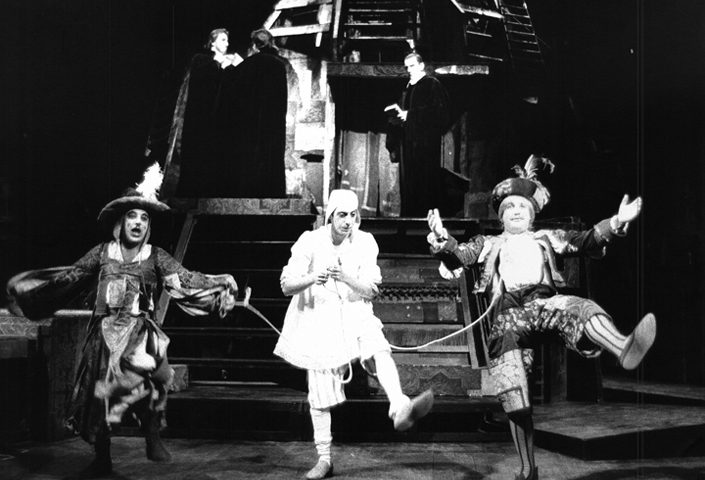Debut: Viterbo, Teatro Unione, 21 December 1979
| Translation | Luigi Squarzina |
| Direction | Luigi Squarzina |
| Assistant director | Gianni Fenzi |
| Set and costume | Emanuele Luzzati |
| Music | Benedetto Ghiglia |
| Production | Teatro di Roma |
Characters and performers
| Vincenzo, Duke of Vienna | Massimo Foschi |
| Angelo, vicar | Roberto Herlitzka |
| Escalo, noble elder | Antonio Ballerio |
| Claudio, a young gentleman | Piero Sammataro |
| Lucio, fantastic | Vittorio Congia |
| 1° gentleman | Bruno Zeni |
| 2° gentleman | Sergio Castellitto |
| 3° gentleman | Walter Corda |
| The Bargello | Stefano Lescovelli |
| Friar Peter | Francesco Calogero |
| Elbow, guard | Giovanni Poggiali |
| Foam, client of brothels | Sergio Castellitto |
| Pompey, servant of madam Strafotta, clown | Gianni Fenzi |
| Abominable, executioner | Francesco Calogero |
| Bernardino, convict | Antonio Cascio |
| A judge | Vittorio Viviani |
| A jailer | Raffaele Montagnoli |
| Isabella, Claudio's sister | Ilaria Occhini |
| Giulietta, Claudio's girlfriend | Liliana Paganini |
| Mariana, Angelo's girlfriend | Marina Tagliaferri |
| Francesca, nun | Antonia Piazza |
| Madama Strafotta, pimp | Donatella Ceccarello |
| The singer | Anita Marini |
| Guards | Nazzareno Meschini Carlo Morelli Enrico Ruggini |
Squarzina staged three editions of this play: in 1957, 1976 and 1979, following different interpretations. Starting from the very first edition, he oversaw the translation, which was considered exquisite, modern, brilliant, and theatrically sound.
In the first edition Squarzina read in the Shakespearian comedy the hypocrisy of censorship, which was in force at the time, with a light and pleasant direction, adhering to the spirit of drama – sober and clear, organic and elegant –, and paying a great homage to culture.
In the second edition he situated the production in its cultural and historical dimension, making Shakespeare our contemporary: indeed, he saw in it “the themes of the ambiguity of religious, political, and judiciary power; of the corrupted and ungovernable city that must still be governed; of order and disorder, inextricably entangled”.
In order to determine the comedy’s cultural and political motivations and its theatrical connotations in the field of Elizabethan theatre, and to understand the possible connections with our own problems in the 1970s, he accompanied the production with university lectures, dedicating to Shakespeare a single-theme course in 1976-77. Squarzina then accompanied the successful encore performances of Misura per Misura in Italian theatres with the essay entitled “Le strutture del teatro elisabettiano-giacobeo” (“The structures of Elizabethan-Jacobean theatre,” 1978).
The production of the second edition, and the observations developed through the single-theme course and in the essay, can be read as references to our national history in the final quarter of the last century. And this is the essential merit of Squarzina’s innovative reading of a great classic: the manifold abuse of power, the hypocrisy of virtue and purity, the unmaking of values and the confusion of moral languages, and iniquity disguised as justice.
The production, although clearly pointing out connections with the political, social and cultural history of England, was projected towards our own time, so much so that “Squarzina’s Shakespeare becomes contemporary... through a reading as humble as it is piercing, made, though, with the vigilant conscience of a modern man”: a deeply examined and head-on reading of modernity, entirely civil (thus political, but not politicised).
The third edition came on the heels of the essay “Brecht e gli elisabettiani” [“Brecht and the Elizabethans”], 1979, wherein he introduced the comparison between Brecht’s “Round Heads and Pointed Heads” and the Shakespearian text, the primary source for Brecht’s play, into his design for the contemporary production, which was not staged because of copyright issues. In this edition, “considering the text’s mysterious quality as a seismograph, the three years that have shocked us between ’76 and ’79 could not but be influential on the main characters’ ideological convolutions and on their interplay... years on top of which power managed once again to return shamelessly to the fore, aided by that very ‘dread’ that in fact reinforced the domination that it claimed to be trying to undermine”.
Shakespeare, once again, is our contemporary.
We thank Teatro di Roma for the concession of the use of photographic material.

